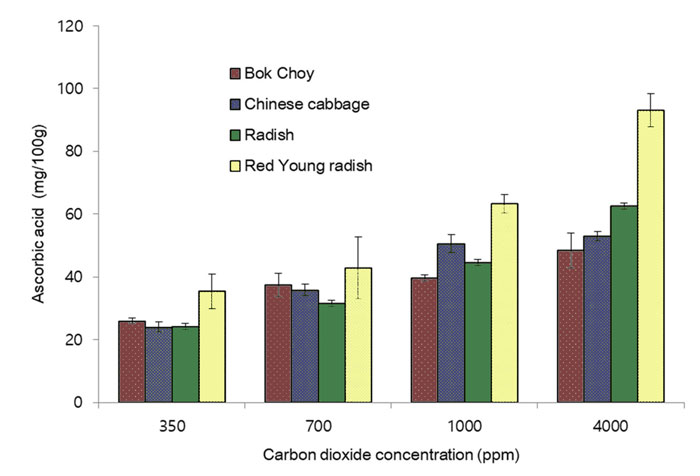| Tweet | Follow @co2science |
Paper Reviewed
Muthusamy, M., Hwang, J.E., Kim, J.A., Jeong, M.J., Park, H.C. and Lee, S.I. 2019. Elevated carbon dioxide significantly improves ascorbic acid content, antioxidative properties and restricted biomass production in cruciferous vegetable seedlings. Plant Biotechnology Reports 13: 293-304.
Writing to introduce their new study, Muthusamy et al. (2019) say that although the impacts of elevated CO2 on "the nutritional quality of crops is being explored continuously, the information on L-ascorbic acid biosynthesis in leafy vegetables like Chinese cabbage (Brassica campestris L. spp. pekinensis Rupr), bok choy (Brassica rapa spp. chinensis) and root vegetables like red young radish (Raphanus raphanistrum ssp. sativus L.) and radish (Raphanus raphanistrum ssp. sativus L.) is limited." Thus it became their objective to investigate the effect of elevated CO2 on various growth and health-related characteristics (antioxidative properties) of these four vegetables known for their high nutritional value, including ascorbic acid, soluble fibers and nutraceuticals with anti-cancer properties.
The work was conducted in the laboratory, where under controlled conditions they grew seedlings of the four plants under four different CO2 concentrations (350, 700, 1000, and 4000 ppm) over a period of 7 days. Thereafter, they performed a series of analyses to determine the CO2 effect on the antioxidative properties of these four cruciferous vegetables.
In discussing their findings, Muthusamy et al. report that elevated CO2 induced a 0.53 to 1.62-fold increase in ascorbic acid (Vitamin C) content in the vegetable seedlings (see Figure 1), which increase they say either directly or indirectly improved the radical scavenging activities of Super Oxide Dismutase in a concentration dependent manner. What is more, elevated CO2 also activated Ascorbate peroxidase-6 to control the accumulation of the reactive oxygen species H2O2.
The above findings are significant in that ascorbic acid "acts as an antioxidant to protect photosystem from free radicals, thereby increasing photosynthesis rate under enriched CO2 conditions which favors high biomass production." Such improvement in antioxidant activities under elevated CO2 thus, not only helped these plants to grow better, but improved their nutritional value. And that is great news for those who grow and consume these vegetables.

Figure 1. Vitamin C (Ascorbic acid, AsA) content in Chinese cabbage, bok choy, red young radish and radish seedlings exposed to different CO2 concentrations (350, 700, 1000 and 4000 ppm). Adapted from Muthusamy et al. (2019).




